(in alphabetical order)
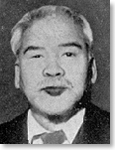
December 23, 1883 to June 7, 1966
An educator and philosopher, Yoshishige Abe was born in Ehime Prefecture. While still a student at the Imperial University of Tokyo, he began publishing literary criticism. He became a professor at Hosei University in 1920 and in 1926 he took a position as professor at Keijo Imperial University in Seoul. He also served in such capacities as the Principal of Daiichi Senior High School in 1940.
He entered the House of Peers after the war in December of 1945. The next year from January to May he was the Minister of Education in the Shidehara Cabinet where he worked on the reform of the education system. Following that, he became the Chairman of the Special Committee on Bill for Revision of the Imperial Constitution in the House of Peers. Until his death in October of the same year, he was President of Gakushuin University.
Photo: Gaho kindai 100 nenshi.18(Kokusai bunka johosha,1952)
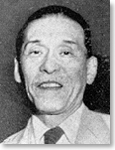
November 15, 1887 to June 20, 1959
A diplomat and statesman, Hitoshi Ashida was born in Kyoto Prefecture. Following his graduation from the Imperial University of Tokyo, he entered the Ministry of Foreign Affairs, and went on to work in Japan's embassies in Russia, France, Turkey and Belgium before he resigned in 1932. He was elected in the general election that year and was affiliated with the Political Friends Association. From then until he died he was a member of the House of Representatives. From 1933 until 1939, he was the President of the Japan Times and Mail.
Immediately following the end of the war, he began planning the formation of a new political party and established the Liberal Party of Japan in November of 1945. He worked as the Welfare Minister in the Shidehara Cabinet from October 1945 until May of the following year. He became Chairman of the Committee on the Bill for Revision of the Imperial Constitution in the House of Representatives in June, and in December he became the President of the Constitution Popularization Society. The next year in 1947, he broke away from the Liberal Party to form the Democratic Party, of which he became the President in May. The month after that he became the Deputy Prime Minister and Minister of Foreign Affairs in Katayama's Cabinet. Following the dissolution of the Katayama Cabinet in March of 1948, he assumed the dual role of Prime Minister and Minister of Foreign Affairs, but he was ousted as a result of the Showa Electric Scandal. He then became part of the Reform Party and eventually reached the top of the Democratic Party of Japan, and in the end, he was an Advisor to the Liberal Democratic Party.
Photo: Gaho kindai 100 nenshi.18(Kokusai bunka johosha,1952)
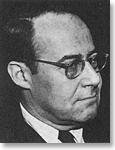
October 20, 1896 to August 17, 1947
Born in Denver, Colorado, George Atcheson, Jr. was a diplomat and political advisor to the Supreme Commander for the Allied Powers. He graduated from the University of California at Berkley. After working as a journalist he went on to become a translator with the U.S. embassy in Beijing in 1920. Following that he spent most of his career in China, where from 1924 to 1939 he worked as a diplomat. In 1941 he worked as Assistant Chief, Division of the Far Eastern Affairs in the Department of State. In 1942 he accepted the position of charge d'affaires at the U.S. embassy in Chungking.
Following the end of the war, the Department of State dispatched him to Japan on September 7, 1945 to work as a political advisor to MacArthur. Atcheson was appointed to the Chief of the newly established Diplomatic Section at GHQ on April 18, 1946. Also starting on April 22, he represented MacArthur on the Allied Council for Japan. He died in a plane crash off the coast of Hawaii while traveling on assignment back to the United States in August 1947.
Photo: Senryoki:shushotachi no shinnihon(Yomiuri shimbunsha,1997)
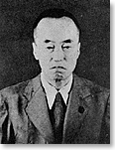
December 3, 1887 to January 20, 1990
A former prince and General of the Army, Naruhiko Higashikuni was born in Kyoto Prefecture the ninth son of the Imperial Prince Asahiko Kuninomiya. In 1906 the Higashikuni household was established. He graduated from the Military Staff College in 1914, and while serving in various locations he visited France to study and graduated from the French Military Academy in 1922. Upon his return to Japan he served as a colonel and then as a colonel commandant. At the start of the War in the Pacific he became Supreme Commander of the Defense Forces.
After the end of the war, on August 17, Higashikuni formed the first cabinet headed by an imperial family member, and signed the Instrument of Surrender. However, unable to accept the "Civil Liberties Directive" issued by GHQ on October 4, he resigned his office on the next day. On October 14, 1947 he renounced his position in the Imperial family after which he became a founder of a new religion.
Photo: Gaho kindai 100 nenshi.18(Kokusai bunka johosha,1952)
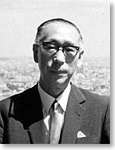
January 10, 1901 to July 18, 1972
A bureaucrat who worked in the legislature, Toshio Irie was born in Tokyo, and upon graduation from the Imperial University of Tokyo entered the Ministry of Home Affairs. In the Bureau of Legislation, he was Counselor in 1927, Director of the First Department in September 1945, Vice Director General in November 1945, and finally Director General of the whole Bureau in March 1946. During this period, Irie worked on the enactment of the Constitution of Japan, and was responsible for formulating laws and statutes related to the new Constitution. In May of 1946, he received an Imperial appointment to the House of Peers. From 1948 he was a Senior Specialist of the National Diet Library, Commissioner General of the House of Representatives Legislative Bureau, and a Justice of the Supreme Court. After retiring in 1971 he became a professor at Komazawa University.
Photo: Private collection
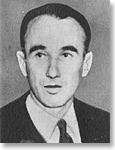
March 12, 1906 to June 18, 1996
Born in Newburgh, New York, Colonel Charles L. Kades was the Deputy Chief of Government Section at GHQ. He graduated from Cornell University and the Harvard School of Law and went on to work as an attorney in New York City. In the 1930s under the Roosevelt administration he was Assistant to Chief Counsel, Bureau of Internal Revenue and Assistant General Counsel for the U.S. Department of the Treasury. At 35 he joined the army, where he was assigned to the War Department's General Staff, Civil Affairs Division. He later served in France. After the war he was promoted from the Chief of the Public Administration Division to Deputy Chief of the Government Section. In Government Section he worked with General Whitney to strongly promote policies for democratization which included the purge of public officials, reform of the Constitution, and dismantling the Ministry of Home Affairs. He played a central part in the framing of the GHQ Draft by writing what is now Article 9 (originally in the preamble). He left the service two years after the enactment of the Constitution on May 3, 1949. After returning home he started work again as an attorney. He died at his home in Heath, Massachusetts, at the age of 90.
Photo: Showa nijunen senkyuhyaku shijugonen(Shogakukan,1995)
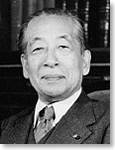
March 17, 1886 to June 16, 1959
A bureaucrat in the Bureau of Legislation and a Minister of State, Tokujiro Kanamori was born in Aichi Prefecture. Upon graduation from the Imperial University of Tokyo, he entered the Ministry of Finance, and in 1914, he moved to the Bureau of Legislation. He became Director of the First Department of the Bureau of Legislation in 1924, and then Director General of the Bureau in 1934, but the "Emperor as an organ of state" incident resulted in his writings being criticized for sounding like Minobe's and he resigned the following year.
After the war, he entered the House of Peers in February 1946, and in June of that year he was appointed Minister of State in charge of the Constitution under the first Yoshida Cabinet. At the 90th Diet Session, he almost single-handedly stood in defense of the draft of the new Constitution reform proposal. From 1948 to 1959, Tokujiro Kanamori was the first Librarian of the National Diet Library.
Photo: National Diet Library's collection
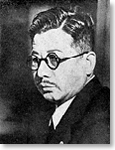
July 28, 1887 to May 30, 1978
A statesman who was active in the social movement, Tetsu Katayama was born in Wakayama Prefecture. After graduating from the Imperial University of Tokyo, he started work as a lawyer. In 1926, he became General Secretary of the Social People's Party at its formation. He was elected to the House of Representatives in 1930. Then in 1932, he became a member of the executive committee of the Socialist Masses Party, but in 1940 he was expelled from the party because he did not attend the plenary session of the House of Representatives in which it was decided to expel Takao Saito, who had given an antimilitary speech.
After the war, he became Secretary General of the Japan Socialist Party when it was formed in November 1945, and in September of the following year he assumed the position of Chairman of the Executive Committee. In the general election of April 1947 his party won a majority, and the following month he became Prime Minister and formed his Coalition Government. The breakup of the Ministry of Home Affairs and reform of the bureaucratic system was done under his administration, but opposition from the Socialist Party's left wing resulted in the dissolution of his Cabinet in February of the following year. In 1951, he was the top Advisor to the Socialist Party, in 1954 he was Chairman of the People's Alliance to Defend the Constitution, and in 1960 he held the position of leading Advisor for the Democratic Socialist Party and acted as Chairman of the New People's Congress to Defend the Constitution in 1961. Upon his defeat in the general election in 1963, he left the world of politics.
Photo: Gaho kindai 100 nenshi.18(Kokusai bunka johosha,1952)
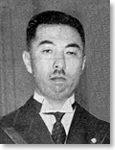
October 12, 1891 to December 16, 1945
A statesman, Fumimaro Konoye was born in Tokyo the eldest son of Prince Atsumaro Konoye. In 1916 he entered the House of Peers, and in 1917, after graduating from the Imperial University of Kyoto, he entered the Ministry of Home Affairs. He was appointed Vice President of the House of Peers in 1931 and two years later in 1933 became President of the House of Peers. An ambitious politician, he became Prime Minister in 1937 and enacted the National General Mobilization Law and pushed for the movement towards a National Spiritual General Mobilization. However, his Cabinet resigned en bloc in 1939. Then in July of 1940, he formed his second Cabinet. The start of the war between Germany and the Soviet Union led to the dissolution of the Cabinet, and his third Cabinet was formed. In October, a lack of progress in negotiations with the United States resulted in the resignation of the Cabinet again, whereupon Tojo brought together his Cabinet. During the final stages of the War in the Pacific, Konoye was working to topple the Tojo Cabinet as well as appealing to the Emperor in February 1945 for an early peace.
Following the war, Konoye was appointed to the Cabinet of Prince Higashikuni as a Minister of State without portfolio. This Cabinet resigned in October, at which time he became an imperial appointee in the Office of the Privy Seal and began work on creating a draft of constitutional revisions. On December 6, an order was issued for his arrest as a suspect of war crimes, and early in the morning of December 16, the day of his arraignment, he committed suicide by taking poison.
Photo: Ushinawareshi seiji:konoe ayamaro ko no shuki(Asahi shimbunsha,1946)
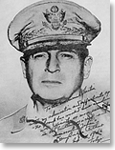
January 26, 1880 to April 5, 1964
A General of the Army of the United States, Douglas MacArthur was Supreme Commander for the Allied Powers during the occupation of Japan. He was born in Little Rock, Arkansas, and went on to graduate from West Point Military Academy at the top of his class. After serving in the Philippines in 1905, he came to Japan as adjutant to his father who was acting as a military observer of the war between Russia and Japan. As Chief of Staff of the “Rainbow Division” (42nd Division) during World War I, he served with distinction and received multiple awards. In 1919 he was Superintendent at West Point. Then in 1930, he was promoted to General and appointed Chief of Staff of the U.S. Army. He was posted to the Philippines in 1935 as a military adviser for the establishment of a Philippine National Army. He resigned from the Army in 1937 to continue working as a military advisor and avoid being called back to the U.S., but in 1941 he resumed his former position and became U.S. Army Commander for the Far East.
With the fall of Manila in 1942, MacArthur pulled back to Australia and began a counteroffensive as Commander of the South Pacific with an alliance of Australian, Dutch and US forces. In October of 1944 he landed on Leyte Island, and in February of 1945 he liberated Manila. On August 13 of that year, President of the United States Harry Truman appointed him Supreme Commander for the Allied Powers. He landed at Atsugi Airdrome on August 30. However, in April of 1951 he was relieved of his duties due to conflicts with President Truman regarding policies for the war in Korea, but until then he was the supreme authority in Japan during the occupation. Following his military career, he assumed the chairmanship of Remington Rand Corporation.
Photo: Political reorientation of Japan, september 1945 to september 1948(U.S.Government printing office,1949)
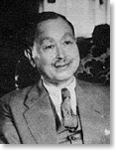
October 14, 1877 to October 8, 1954
Joji Matsumoto was born in Tokyo. In 1900, he graduated from the Imperial University of Tokyo where he had studied commercial law. In 1903 he became an assistant professor at the Imperial University of Tokyo and in 1909 was granted full professorship. He resigned from the university in 1919 and took a position with the South Manchurian Railroad Co., Ltd., in 1921 where he was promoted to vice president. He was Director General of the Bureau of Legislation under the second Yamamoto Cabinet in 1923. Following that he was in the House of Peers from 1924 to 1946. In 1934 he became the Minister of Commerce and Industry. He also worked on the board of directors of several companies and was on the board of directors of the Bank of Japan. During this period he contributed to the reform of commerce law and other legislation.
After the war, Matsumoto took on the duties of Chairman of the Constitutional Problems Investigation Committee as Minister of State in charge of the Constitution in October of 1945 under the Shidehara Cabinet. He was the central figure in the creation of the "Gist of the Revision of the Constitution," which was submitted to GHQ on February 8, 1946. In May of 1946, he was purged from public office, but was called back in October of 1950. In December of that year he became Chairman of the Committee on Public Utilities and began a reconstruction of the electric power industry.
Photo: Kaishaho no shomondai:matsumoto sensei koki kinen(Yuhikaku,1951)
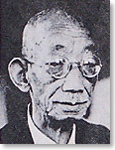
May 7, 1873 to May 23, 1948
A constitutional scholar and expert in administrative law, Tatsukichi Minobe was born in Hyogo Prefecture. After graduating from the Imperial University of Tokyo, he took a job in the Ministry of Home Affairs, but left this position to pursue his studies in Europe. While overseas, he became an assistant professor in the College of Law at the Imperial University of Tokyo, and received a full professorship upon his return in 1902. He advocated the theory of the emperor as an organ of state that turned into a heated dispute with Shinkichi Uesugi over the Emperor's Prerogative. An advocate for a liberal interpretation of the Meiji Constitution, he was active in the movement for its democratization. From 1924 to 1927, he was the Director of the Faculty of Law at the Imperial University of Tokyo, which he finally left in 1934. During this period, from 1911 for 34 years, he was also a counselor in the Bureau of Legislation where he participated in the enactment of several laws. After he entered the House of Peers in 1932, the doctrines he advocated drew the enmity of the military and the right wing, until finally in 1935 his writings were banned and he was accused of lese-majesty and removed from the House of Peers in what was to become known as the incident of the "theory of the Emperor as an organ of state."
Following the cessation of hostilities, he was active in the foundation of the Constitution of Japan: in October of 1945 he became an Advisor to the Constitutional Problems Investigation Committee as well as becoming an Advisor to the Privy Council in the following year.
Photo: Atarasii kenpo no hanashi(Asahi shimbunsha,1948)
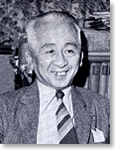
March 6, 1899 to September 4, 1976
A constitutional scholar, Toshiyoshi Miyazawa was born in Nagano Prefecture and graduated from the Imperial University of Tokyo in 1923. In 1925 he became an assistant professor at the university. He studied in Europe and America as he researched public law, and in 1934 he became a full professor. He took over from Tatsukichi Minobe as an instructor of constitutional law at the Imperial University of Tokyo. Immediately after he became a professor, the attack on Minobe's "theory of the emperor as organ of the state" occurred. He challenged authoritarianism in his criticism that the government gave the official interpretation of the Constitution. However, as the situation changed, he lost the support needed to develop his theory of constitutional rationalism.
After the war, he took part in efforts to bring together proposals such as the "Gist of the Revision of the Constitution" as a member of the government's Constitutional Problems Investigation Committee. In May of 1946, he brought out his "Account of the August Revolution" which argued that the "Structure of the Imperial State" was already negated through the acceptance of the Potsdam Declaration. He received an Imperial appointment to the House of Peers in August, and participated in the deliberations on the Constitution, in which he expressed the idea that to create a democratic Constitution for Japan the principle of Imperial Supremacy in the Meiji Constitution had to be fundamentally revised, and he criticized the attitude of the government for trying to change the Constitution without changing the "National Polity." After the enactment of the Constitution, Miyazawa wrote what is considered the standard textbook on the Constitution and its annotated edition. After retiring from the University of Tokyo in 1959, he became a professor at Rikkyo University. He became the Commissioner of Professional Baseball and was busy in a wide range of fields outside of his academic life.
Photo: Kamigami no fukkatsu(Yomiuri shimbunsha,1955)
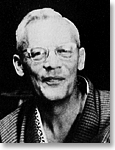
July 25, 1903 to October 7, 1977
Milo Rowell, lieutenant colonel and the Judicial Affairs Officer at GHQ, was born in Fresno, California. After graduating from Stanford University, he entered the Harvard School of Law. In his second year he transferred to Stanford Law School where he received his Doctor of Jurisprudence. In 1926 he started work as an attorney in Fresno, California, and enlisted in the army in 1943. During World War II he studied military occupation administration and also worked as an instructor. He also fought as a commander on the front lines in the Philippines. In 1945 he was assigned to GHQ as Chief of the Judicial Affairs Office. Chiefly concerned with the problem of revising the Constitution, he analyzed the Meiji Constitution and reviewed the draft proposed by the Constitution Investigation Association. He was a member of the Steering Committee, which guided the creation of the GHQ Draft.
In 1965, Rowell sent his papers (known as the Rowell Papers) to Kenzo Takayanagi, Professor Emeritus of Anglo-American Law at the University of Tokyo and Chairman of the Cabinet Commission on the Constitution. The Rowell Papers contain records from GHQ regarding the revision of the Constitution. These documents provide a previously little-known perspective of the activities at GHQ surrounding the process of revising the Constitution.
Photo: MacArthur(Nihon hoso shuppan kyokai,1982)
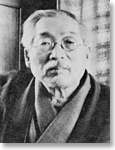
March 28, 1878 to August 4, 1965
A constitutional scholar and expert in administrative law, Soichi Sasaki was born in Tottori Prefecture. He graduated from the Imperial University of Kyoto in 1903 and became an associate professor there in 1906. He began teaching Administrative Legal Studies as a full professor in 1913, and took on the additional role of teaching Constitutional Law in 1927. He argued for a Constitution that combined a stringent literal interpretation with a theory of constitutionalism and was active as the philosophical leader of the Taisho Democracy along with Tatsukichi Minobe in Tokyo. In 1933 he resigned in protest of the "Takigawa Incident." Sasaki was also central to the protest movement staged by the Union of Professors in the Department of Law, and he fought for protection of the autonomy of universities.
After the war, Konoye appointed him commissioner to the Lord Keeper of the Privy Seal, where he worked together with Konoye to draft the revisions to the Constitution. In 1946, he took part in deliberations on the Constitution of Japan as a member of the House of Peers.
Photo: Sasaki kenpogaku no kenkyu(Horitsubunkasha,1975)
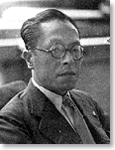
May 1, 1904 to September 12, 1974
A bureaucrat in the Bureau of Legislation, Tatsuo Sato was born in Fukuoka Prefecture. After graduating from the Imperial University of Tokyo, he entered the Ministry of Home Affairs. In 1932, he became a Counselor in the Bureau of Legislation.
The war ended while he was the Director of the Second Department in the Bureau of Legislation. He then took on the duties of the Director of the First Department, and in March of the following year he was promoted to Vice Director General of the Bureau of Legislation. During this period, he was deeply involved in the process of establishing the Constitution of Japan. In 1947, he became Director General of the Bureau of Legislation. After leaving his post there in 1954, he worked as a Senior Specialist at the National Diet Library, and from 1962 to 1974 he was the President of the National Personnel Authority.
Photo: Yoshida naikaku kinen shashincho(Rengo shashin tsushinsha,1953)
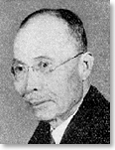
September 13, 1872 to March 10, 1951
A diplomat and statesman, Kijuro Shidehara was born in Osaka. After graduating from the Imperial University of Tokyo he entered the Ministry of Foreign Affairs. From 1915, heavily involved in wartime diplomacy, he worked on peace treaties at the end of World War I as the Vice Minister of the Ministry of Foreign Affairs. In 1924 he assumed the position of Minister of Foreign Affairs in the Cabinet of Takaaki Kato. He continued in this position in the first Wakatsuki Cabinet, as well as the Hamaguchi Cabinet in 1929, and again in the second Wakatsuki Cabinet where he promoted what was known as "Shidehara Diplomacy." He improved relations between Japan and China, and was influential in the signing of the London Naval Disarmament Treaty.
He was well known in the United States and a pro-American. He spoke fluent English, and after the war when the Higashikuni Cabinet resigned he assumed the position of Prime Minister on October 9, 1945. Starting with the "Five Major Reform Directives" and the "Liberalization of the Constitution" among other orders issued by MacArthur, the Shidehara Cabinet initiated directives that dismantled the Zaibatsu and reformed land policy. He directed his efforts at the continuance of the Emperor System, the Emperor's declaration of his humanity, and acceptance of GHQ's proposed revisions to the Constitution. After the general election in April of 1946, plans to continue his administration came to nothing as he assumed the presidency of the Progressive Party, which came in second in the general election. He continued his political career as Minister of State in the first Yoshida Cabinet. In 1947, he was elected to the House of Representatives. Later he went on to become honorary president of the Democratic Party, and worked as the top advisor to the Democratic Liberal Party. In February of 1949 he became the Speaker of the House of Representatives, and later died in office.
Photo: Yoshida naikaku(Yoshida naikaku kankoukai,1954)
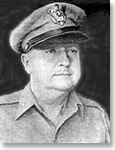
May 20, 1897 to March 21, 1969
A Brigadier General acting as Chief of Government Section at GHQ, Courtney Whitney was born in Washington, D.C. and joined the army in 1917. He earned a degree in law at George Washington University before leaving the service in 1927 to pursue a career as a lawyer in Manila. He reentered military service in 1940, and in 1943 he was in command of guerillas fighting against Japan in the Philippine Islands as a staff officer under MacArthur as a member of what were known as the "Bataan Boys."
He landed at Atsugi Airdrome with MacArthur in August of 1945, and became the Chief of Government Section at GHQ in December of that year. Taking on this role, he pushed for a policy of democratization from the beginning of the occupation. During the making of the Constitution of Japan, he directed Government Section's efforts to create a draft of the Constitution, and handed the GHQ draft to Joji Matsumoto and other Japanese government officials on February 13, 1946. In 1951, when MacArthur was decommissioned, Whitney also left the service.
Photo: Political reorientation of Japan, september 1945 to september 1948(U.S.Government printing office,1949)
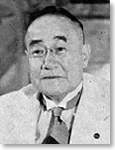
September 22, 1878 to October 20, 1967
A diplomat and statesman, Shigeru Yoshida was born in Tokyo. He was the fifth son of the civil rights activist Tsuna Takenouchi of Tosa, but was sent to live with industrialist Kenzo Yoshida who later adopted him. He entered the Ministry of Foreign Affairs in 1906 and served as the Consul General in Tianjin and then in Mukden. He was appointed Vice Minister of the Ministry of Foreign Affairs under the Cabinet of Giichi Tanaka. Later, he became ambassador to Italy and then to the U.K., but left the ministry in 1939. He was against going to war with the U.S. and was also arrested by the military police for championing peace during the war.
He became the Minister of Foreign Affairs in the Cabinet of Prince Higashikuni, a position he held in the Shidehara Cabinet as well. Following this in May of 1946, he became President of the Liberal Party of Japan upon Ichiro Hatoyama's ouster from public office, and he became a member of the first Yoshida Cabinet. After the Katayama and the Ashida Cabinets, he returned to the Cabinet again in 1948, where he held the position of Prime Minister until 1954. During this time he carried out negotiations with GHQ to set up a policy of democratization, and was a signatory to the San Francisco Peace Treaty and the Security Treaty between Japan and the U.S. He made a great contribution to laying a foundation for the Japan's postwar reconstruction and worked to cultivate Japan's future statesmen.
Photo: Yoshida naikaku(Yoshida naikaku kankoukai,1954)